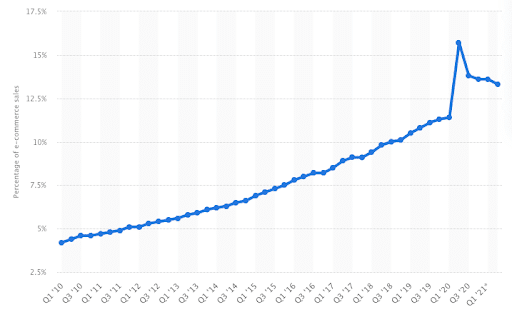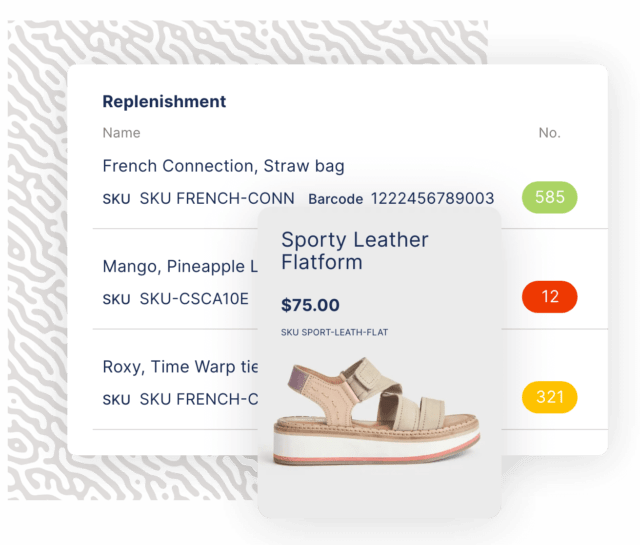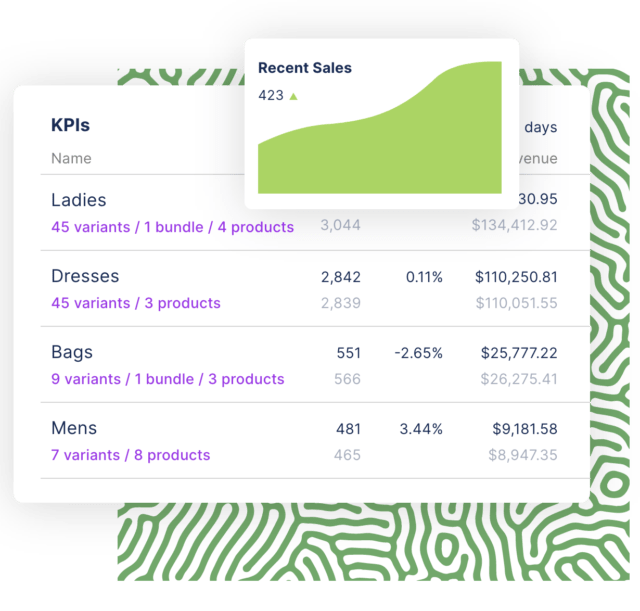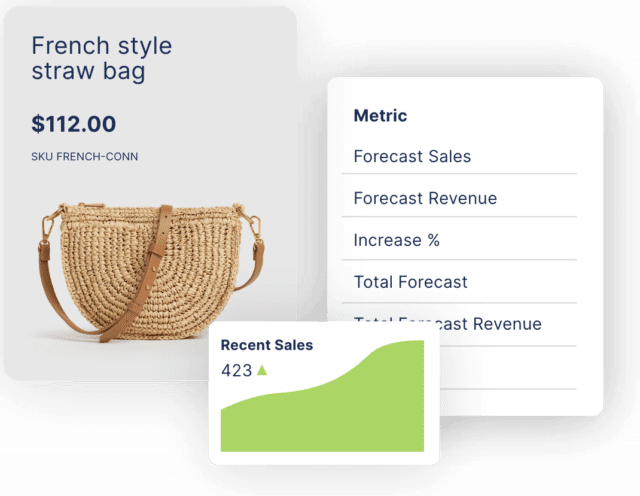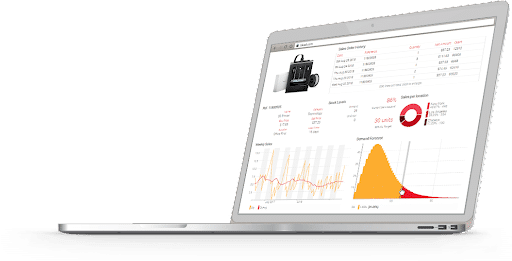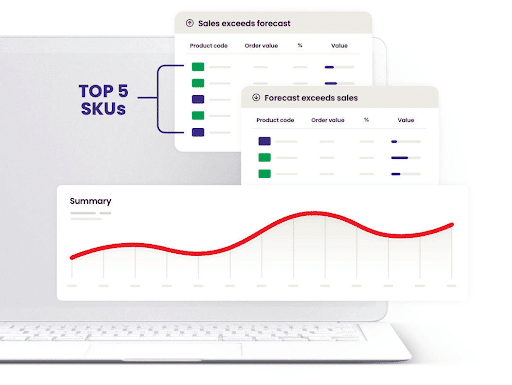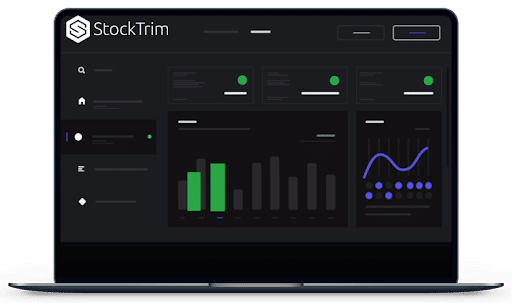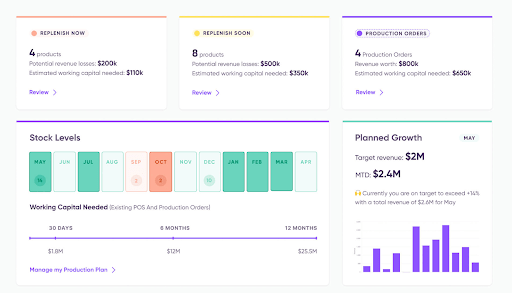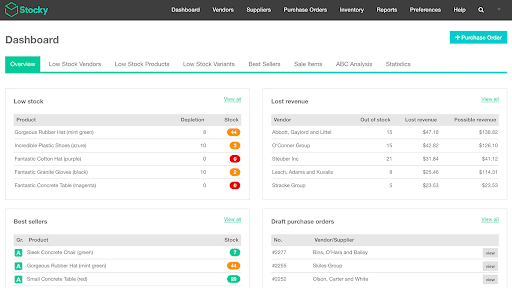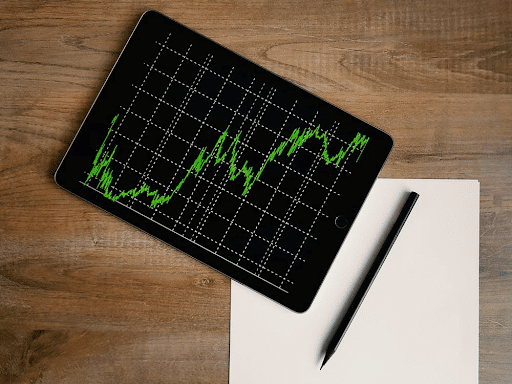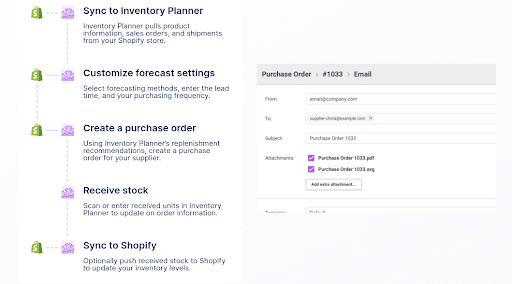When you’re looking for retail demand planning software, it can be difficult to narrow down the top demand planning software out of all the options that exist out there.
Not to worry – that’s what we’re here for!
In this article, we’re going to go through what demand forecasting software is, as well as the ten best choices available on the market and how they compare with each other. This will make it a lot easier to figure out which option is the perfect one for you, whether you’re looking for demand planning software for a small business, a large enterprise, or anything in between.
First, let’s go through some of the basics behind forecasting and planning software.
What is demand planning software?
In the most literal terms, demand planning software is, well, software for demand planning. It’s a tool that’s created with the specific purpose of helping businesses predict, plan, and prepare for future customer demand.
However, excellent demand planning software also goes a step beyond inventory ordering and planning.
It focuses on helping businesses be as prepared as they can be for the future by creating predictions for business’ long-term needs, such as the type of inventory that will be required and when it will be required, so they can accurately get ready for what their demand will look like going forward. Predictive analytics allow demand planning tools to do this.
Why is demand planning software important in the market?
You know what demand planning software is, but why is it so important to have access to this kind of software in the first place?
There are two parts to the answer to this question.
First, there’s the state of the market itself. E-commerce businesses are part of a busy sector that’s only becoming more popular as time goes by and new tech is created. In fact, as the following graph shows, e-commerce growth has gone up hugely in recent years:
This tells us two things very clearly. First, there’s a major demand for e-commerce businesses, so the growth you can see above is likely to continue into the foreseeable future. Second, e-commerce growth is not linear, and neither is customer demand.
So then you need to figure out how you can stand out and how you can be properly prepared for changes in the market itself and in the demands of the customers. Demand planning software lets you do both of these things.
It’s also important to note that demand planning software helps companies understand customer demand as it fluctuates and changes rather than ignoring real-time trends.
Excellent demand planning software gives you multiple types of demand forecast options, so you’re always ready to meet your customers’ needs. This sets your business apart as an excellent one for customers while ensuring you keep pace with rapid growth as it unfolds.
That leads us to the second part of why this software is so important in the market. Check out demand planning software reviews, and you’ll find lots of businesses expressing how helpful demand planning software has been to them.
It enables businesses to achieve inventory optimization based on demand, which optimizes their bottom line. It secures business continuity and saves money, both of which are incredibly important to modern businesses.
Benefits of demand planning software
So, what are some of the big reasons why businesses invest in demand planning software?
The following benefits come with using this type of software, and they make it much easier to run your business successfully. Let’s jump in and take a closer look at some of the main reasons why choosing demand planning solutions is so worthwhile.
Reduce the cost of inventory
There’s more to running a successful business than providing the highest service levels and making stakeholders happy. You’ve also got to make sure you’re paying enough attention to your own bottom line.
One of the main things affecting the profits you get left with is the cost of your inventory. While it’s a good thing to have some safety stock, you don’t want to be left with warehouses full of products that aren’t selling because that’s a major waste of money (and it puts a strain on the budget).
That’s where inventory planning software comes in.
Great planning software shows you exactly what you need to stock, what quantities you need to stock, and when you need to stock the relevant products.
It also takes things like seasonality into account, ensuring you’re accurately forecasting holiday sales and preparing for the demands of busier seasons.
What that means for your business is that you don’t have to worry about overstocking or understocking anything. Your demand planning software has that covered for you, so you get to be fully prepared while also saving money that would’ve otherwise gone to excess stock.
Effective and streamlined processes
Between getting in touch with (potentially lots of) distributors, manually calculating demand and the resultant supply need, and checking in on your company’s current inventory status, there’s plenty for e-commerce business employees to do in a day. In fact, these processes can quickly become overwhelming or even muddled.
Thankfully, demand planning software helps with that.
The right kind of software will show you everything you need on a single dashboard. It helps you connect with the right distributors at the right time, works out your demand for you, and much more.
The end result is a business that runs on streamlined workflows thanks to the help that demand planning software provides.
Accurate and reliable forecasting
Trying to plan for the future can be very difficult – that is, unless you’ve got the kind of accurate demand forecasting that demand planning software gives you access to.
The best software forecasts reliably based on a variety of factors. Those include your historical data, your current situation, the market’s status, and more. It uses this information to make highly accurate predictions that keep you prepared, ensuring you always know what’s going on.
It’s important to also note that demand planning software does more than just make an “educated guess”.
What it does is run data-based, algorithm-backed calculations that give you the highest degree of accuracy.
Keeping predictions accurate is crucial for businesses to be able to prepare adequately, and it’s becoming more complicated thanks to the sheer volume of data that’s being generated each day.
Take for example the graph below showing the volume of data/information created, captured, copied, and consumed worldwide from 2010 to 2020, with forecasts from 2021 to 2025 (in zettabytes):
That exponential explosion in data generation makes it increasingly difficult for human employees to keep up with e-commerce demand planning needs. That’s why you’ll want to rely on demand planning software to do it for you.
Prevents inventory shortage
We’ve gone through how damaging it can be to have too many copies of a product that isn’t selling, but what about the reverse situation? What if you’re rolling out a new product, and your demand exceeds the levels you can supply for?
New product introductions are enough work without having to contend with inventory shortage as well. Demand planning software can help prevent them.
Using the same machine learning algorithms that predict demand and show you how to avoid ordering too much stock, demand planning software gives you the tools you need to stop inventory shortages before they happen.
In fact, in many cases, you can even set up your demand planning software to order your necessary stock for you. This saves time for your employees.
When you never suffer inventory shortages, your customers will see you as a brand they can trust to have all the items they want in stock. In other words, demand planning software can even help you boost your reputation among your target audience.
Improve productivity of the team
As we’ve mentioned already, demand planning software frees up a lot of time in your human employees’ schedules, essentially acting as a robotic employee. That’s doubly true when your chosen software solution includes automation options.
This isn’t the only way in which it boosts productivity, though.
By gathering the data you need for demand planning, your software makes it easier for employees to work with that information to productive ends. That means getting even more done in even less time.
Productivity is a deceptively simple concept that has the power to transform your business from the ground up. That’s because poor productivity levels can be very costly. Consider the fact that three factors alone can cost you over $1 billion in annual revenue:
That’s why demand planning software emphasizes productivity and why it’s so important to pick the right software for your team’s productivity needs.
Top 10 demand forecasting & planning software for e-commerce businesses
The process of forecasting and planning is both crucial to business continuity and tricky to do perfectly. That’s why many businesses turn towards specialized software to help them.
These ten software selections are the top ten out there, in our humble opinion.
We’ve also provided details on the pricing options you can expect for every item on the list. This helps with two things: transparency and business planning. After all, not everyone has the same budget, so we want to empower businesses of all sizes to pick an option that fits their needs.
1. Inventory Planner
We believe Inventory Planner is the top choice for inventory forecasting and planning for e-commerce and multichannel businesses, and we’re going to walk you through the reasons why.
The number one reason, Inventory Planner gives you ultimate accuracy in sales forecasting, which is fundamental for any Inventory Planning software.
In order to keep inventory levels right, merchants need to know exactly what and how much they’re going to sell.
Inventory Planner predicts sales for both seasonal and non-seasonal products and factors in variations like market fluctuations, festive seasons like Black Friday, Christmas, promotions or any marketing events that may impact future demand for ultimate accuracy.
The result? Inventory Planner gives you reliable inventory purchasing recommendations based on the accurate calculation of your future sales. So you’ll know exactly how much inventory is needed, when it’s needed, and which warehouse each item needs to go to.
Plus, Inventory Planner translates all the complex yet fine-tuned sales predictions and inventory forecasting data into intuitive recommendations. For instance, simply use the “Forecast lost profit” metric to identify the items that need immediate replenishment to avoid profit loss.
This means you’ll never need to worry about stockouts or overstock, thanks to Inventory Planner’s accurate demand forecasting and reliable purchasing recommendations to meet demand. In other words, you can stop losing money on stocked-out items without having too much cash tied up in slow-moving products.
At the same time, Inventory Planner is more than an inventory forecasting tool.
It’s also an excellent piece of software to rely on when you’re trying to gauge your inventory performance. That’s because Inventory Planner gives you intuitive, customizable inventory performance reports, which give you full visibility of how your inventory is performing.
With Inventory Planner, demand forecasting and inventory purchasing decision-making are easier than ever before.
The monthly cost for Inventory Planner is $119.99, but users looking for access to four+ warehouses and over 10,000 SKUs, or businesses that want expert-led forecasting configurations and bespoke training, will likely want to get in touch for a custom quote.
2. LOKAD
Marketing itself as “supply chain optimization software,” LOKAD is a planning platform that’s designed to help you improve all supply chain processes, from purchasing to production and beyond.
LOKAD is a solid supply chain planning tool. Optimization of your supply chain processes is simpler with LOKAD, meaning that you get to ensure every step of your supply chain operates seamlessly.
LOKAD uses probabilistic forecasting models. These are intended to help you maximize profits from each piece of stock.
All in all, LOKAD is a user-friendly piece of supply chain management software that chooses one niche – but performs very well within that niche.
A bit of a downside to consider with LOKAD is its high cost. Starting at $3,000 per month but going up to over $8,000 monthly, depending on your industry, it’s not suited for anyone with strict budgeting needs.
3. Netstock
Emphasizing the need to connect ERP and inventory planning, Netstock analyzes ERP data in real time to empower you to place orders and plan sales operations as optimally as possible.
It takes third place on our list of top demand planners, and for good reason.
Its automation features are robust, meaning your items get categorized automatically with minimal human input. Netstock also makes it easy to view your inventory KPIs and make educated decisions based on them.
Some reviews have cited delays in updating or refreshing data, as well as limitations in the dashboard’s coverage.
Another thing to bear in mind if you’re considering Netstock is that its pricing options depend entirely on your business. Before giving you a quote, Netstock’s pricing calculator will prompt you to enter some details about your company, such as the country you’re based in and your net worth.
4. NetSuite Demand Planning
NetSuite Demand Planning is an ERP demand planning tool that’s designed under a one-size-fits-all motto. That means it’s effective, provided that your brand’s needs happen to line up with the features the company offers.
In other words, if you’re a cookie-cutter brand, it’s worth considering NetSuite.
That includes being alright with waiting 420 days for implementation to be complete. With a 25% implementation success rate, however, NetSuite Demand Planning may realistically take longer to be properly implemented.
5. Restock Pro
Restock Pro is the first item on this list that’s aimed specifically at Amazon sellers. It converts FBA data into intelligence that helps you track your key stock metrics (and levels).
Thanks to its status as a cloud-based tool, Restock Pro is well-suited to remote and hybrid work. It can be accessed from anywhere with access to the cloud storage data, giving it a touch of flexibility that elevates it above some of the other entries in this list.
With prices starting at $99.99 per month, Restock Pro falls on the more affordable side of the pricing scale.
6. Stock & Buy App
The focus of the Stock & Buy App is more inventory and order management software with light inventory planning functionality. It’s a good all-around inventory solution for small businesses that only need integrations to Shopify.
It’s important to note that while Stock & Buy comes with great inventory management features, it’s not focused on predictive analytics. This makes it less ideally suitable for anyone looking for a platform with demand management capabilities that can manage their stock using predictive models or demand sensing features.
Following a free two-week trial, Stock & Buy is going to cost you $149 each month. It also offers the opportunity to purchase extra add-ons – which will then also be charged monthly, depending on the specific choices you go with.
7. Stock Trim
A piece of smart inventory forecasting software, Stock Trim is specifically aimed at small and medium-sized businesses rather than enterprises.
As its name suggests, Stock Trim helps users cut down on their excess stock. That reduces the chances of items sitting in warehouses, untouched, instead of being sold. It also makes it easier to turn a profit with integrated business planning.
In the sales and operations planning (S&OP) ecosystem, Stock Trim fits into three key spaces: accounting, inventory management, and inventory forecasting. This makes it an aggregate solution.
Despite the fact that it’s aimed at small and medium-sized businesses, Stock Trim’s plans can be quite costly.
Stock Trim offers three main pricing plans, plus a fourth Enterprise-level tier that has to be discussed with their sales team directly. Their cheapest plan, Starter, costs $99 monthly. Growth and Ultra are their more expansive plans, running at $199 and $299 each month, respectively.
8. Cogsy
Cogsy is a new solution, having only hit the market very recently (in 2020). This means that while it aims to help you drive business growth using your sales data, it realistically hasn’t had enough time to fine-tune the technology to do so as accurately as older solutions like Inventory Planner can.
Unlike Inventory Planner, Cogsy doesn’t offer forecasting for multiple warehouses, and they only have ten integrations. Inventory Planner, on the other hand, has over thirty native integrations, as well as a CSV connector.
An important thing to pay attention to with Cogsy is that it’s not necessarily designed for small businesses. That’s because its pricing plans are geared toward companies with more revenue than your typical small business or startup makes.
By default, Cogsy offers four separate pricing plans, plus a fifth that’s priced on an individual basis. These plans are divided according to your business’s annual revenue. The cheapest plan is exclusive to businesses that earn $5 million or less each year and costs $200 each month. The most expensive, in comparison, runs at $1,000 per month.
9. Management One
The aim of Management One is to help users create strong plans using its “consulting” approach and to use those plans to drive your company’s growth.
It’s a planning solution that’s suitable for businesses looking for help from retail experts and from the Retail ORBIT predictive analytics platform that they use.
With the help of visualizations and on-demand reporting, Management One enables you to accurately predict sales, as well as the relevant level of stock that you require.
However, Management One is really only about creating data-based plans. It’s not designed with automation in mind, making it a tool with fewer purposes than an all-inclusive platform like Inventory Planner.
Pricing plans for Management One are worked out on a case-by-case basis. That means that you’ll have to reach out to them to get an idea of how much you’d have to spend to use it.
10. Stocky: a free demand planning software
Taking up the last spot on this list is Stocky, our pick for a free piece of software that can help you throughout the demand planning process.
Stocky is owned by Shopify. It’s an app you can download directly from your Shopify account, meaning you can use it together with Shopify if that’s where your e-commerce store is based. This makes Stocky a solid choice for Shopify users.
Since Stocky is a piece of free demand planning software, there’s no pricing model to speak of. That does also mean it’s less flexible, adaptable, and feature-rich, but if you’re only looking to try out a free solution, we do think it’s one of the better ones.
How to Select the Right Demand Forecasting & Planning Software for your Business
Now that we’ve gone through the top ten demand planning software, you might be wondering how to pick the right software for your business in particular. Don’t worry. We’ll show you which important factors to consider as you narrow down your list.
Before we get into some practical tips, it’s worth noting that you’ve got to know exactly what you want from a tool before you start trying to choose one.
For example, if you’re focused on forecasting customer demand more than keeping track of the current state of your inventory, you’ll want to home in on the tools that have the same emphasis.
With that being said, let’s look at the tips we’ve compiled.
Know the scope of the processes
This is the first step, and perhaps the most important one, when you’re selecting the right demand planning software.
You need to know what you want your tool to do, as well as how involved you want it to be in your employees’ work schedules. Do you want an analytics tool or one that will help your employees streamline all their workflows? Are you looking for something small or all-inclusive?
These are the kinds of questions you have to answer to narrow down the scope.
The more closely you can pin down the scope that you’re going for, the easier it’ll be to determine whether a given piece of software suits your needs or not.
Consider the team’s learning curve
Your team members are the ones that will have to learn how to use the software you choose, and that’s something to take the time to consider carefully.
If you go for a more complex piece of software, for example, you might offer your team more benefits in the long run. However, if they don’t have the time to learn the ins and outs of all the features a complex tool offers, that tool might end up being more of a hindrance than a help.
The reverse is also true. That is to say that if you provide your teams with a very simple tool, they’ll likely pick it up quickly. But all their complex needs might not be met.
In other words, you’ve got to take a realistic approach to your team’s learning curve.
A few questions will help you get there.
How much time do they have to spend on a piece of software, for example? And how complex is the software you’re considering? Also, how intuitively is the software laid out?
The last question, in particular, is always worth considering. The most easy-to-use software can become daunting to learn if it’s not set up in a user-friendly way. So it’s well worth looking for software with a simple and intuitive layout.
Check the costs
Unfortunately, no two budgets are created equal, and some companies have major limits on theirs.
That doesn’t mean you need to be locked out of options, though. It does mean that it’s always a good idea to spend some time checking out the costs you can expect to pay for your demand planning software of choice, as well as how those costs would fit into your budget.
Different providers use different pricing models. In the case of demand planning software, practically every option relies on paying a set monthly fee in exchange for the features that the software offers.
However, there’s something very important to pay attention to here: minimum costs versus total costs.
Plenty of companies will show you a base cost for their software. However, that base price usually doesn’t cover useful add-ons you might need, so you’ll need to tally those up to get a more grounded idea of how much you’ll actually be paying.
Also, pay attention to invisible costs such as dedicated headcount costs. Some ERP types of demand planning software, such as NetSuite Demand Planning, will require a dedicated headcount to configure and maintain the system.
Assess the vendor
Just because a provider looks good on the surface doesn’t mean they’re the perfect fit for you. They need to be able to prove that they are, and this is the stage for them to do that.
Of course, you don’t always need to get in touch with the vendor for this, but it does help. Directly contacting a prospective vendor’s customer service department can be a great way to get insight into how they treat customers.
If you come away from an interaction with the company feeling valued and heard, that’s a good sign you’ll keep feeling that way if you choose them.
On the other hand, there’s also plenty of assessing you can do without the vendor’s input.
For example, how good are their online customer reviews? Is the company well-backed? How long has the business been established? Do they provide enough support? Do they offer a free trial, and how transparent are they about this? Can you easily see whether they offer every feature you need?
These are the kinds of questions you can use as a guide to help you assess the vendor’s suitability for your company. You’ll likely find that one of your choices comes out on top, and that’s a great indication of how you’ll feel once you’ve partnered with them.
Features of Great Demand Forecasting & Planning Software
We’re going to take a step back here and look at the bigger picture: namely, demand planning software as a whole and what makes a piece of software great.
The following features are essential, if not highly desirable, in a solid demand planning and forecasting tool. If you’re considering a platform that’s missing two or more of these features, it might be time to look elsewhere.
Analytics and reports
Modern businesses generate lots of data, as we’ve discussed already, and an excellent piece of demand planning software should help you harness that information to your business’s advantage through reporting and analytics.
Reports provide insight into what’s happening with your inventory. That’s especially useful for staying on top of real-time developments, as well as making it easier to plan for the future.
Likewise, analytics turn your raw data into something your company can use to grow. They help guide your decisions, business plans, and more.
Your demand planning software should always empower you to make the most of the power of data. That’s why analytics and reports are absolutely crucial to a great piece of demand planning software and why you should always check out these features before investing in one.
Forecasting accuracy
It’s critical to demand planning software, especially in this constantly changing market. In the retail sector, market trends are evolving all the time, and customer demand can shift based on seasonality or your own marketing activities.
So it’s very important to make sure that the software can cope with different business needs and a wide range of market fluctuations for ultimate accuracy.
It’s also very important to make sure that the software can tell a real demand pattern from an unusual one-off shift for extra accuracy, as you probably don’t want to over-buy or under-buy because of random, temporary demand shifts.
Distribution analysis
Your stock is always going to be distributed across at least two locations, likely more if you’re a larger or multinational company. It’s important to know how your stock is distributed throughout your warehouses or other locations, which is why demand planning software should help you see this.
Ideally, your software tool should do more than show you where your stock is. It should be able to explain the reasons why a piece of stock is located where it is.
Even distribution isn’t always the end goal, either. Your software should be able to tell you whether stock is distributed appropriately rather than necessarily evenly.
That’s because your demand might not be even throughout locations. For example, a particular product might be hugely popular in one location but almost unheard of in another. In which case, your distribution should reflect this.
To put it another way, stock distribution happens in response to demand, so it should be incorporated into your demand planning software.
Reliable native integration
Regardless of which platform your e-commerce store is based on, you’ll want to find a tool that can easily integrate with, and sync to, the information on that platform.
Inventory Planner, for example, comes with easy integration processes for Amazon, Shopify, and various other popular platforms. Here’s how quick and simple the Shopify sync-up process is when you choose Inventory Planner:
There are loads of reasons why native integration is important, so we’ll cover the main ones.
Firstly, complicated, customized integration takes time. The more steps there are, the longer setup takes, and that means wasting time and losing productivity throughout the day.
Secondly, when integration involves too many steps, there are lots of chances for things to go wrong. This increases the risk factor for businesses looking to make a new investment, and that’s not something anyone’s looking for.
Next, there’s the fact that easy integration shortens the learning period for employees. They gain back the time and effort they’d otherwise spend trying to figure out a complex installation and setup process, which gives them more chances to familiarize themselves with the new program.
Lastly, native integration reduces the chances of friction between the new software and the tech you’re already using.
Life cycle visibility
Unless you’re a company that only sells one variety of a single product, chances are, you can’t look at a piece of stock and instantly know how long it’s been in your warehouse.
That’s where demand planning software comes in.
Great software will give you clear, uncomplicated insight into your products’ life cycles. This helps you determine how long something has been in rotation, as well as how its popularity has changed over time.
Life cycle visibility also makes it easier to plan for the future. That’s because it shows how long a particular type of product can expect to keep seeing demand, as well as which versions of a product are the most popular.
For example, let’s say you sell shoes. You’re preparing for winter, so you want to know which kinds of winter shoes have sold well in the past. Your demand planning software tells you that brown ankle boots, in particular, are consistently popular and never spend long in a warehouse once the cold weather sets in, but that red knee-high boots have seen a recent surge.
This information would help guide you in your stocking choices. You might keep ordering the same quantities of brown ankle boots, but based on the fact that the red ones are suddenly spending less time in the warehouse before being shipped out, you’d likely spend more on them this season.
Scalability
Last but not least, the software should also grow and develop with your business. If your business has increased in size since the previous year, this should be reflected in the forecasts your software generates.
In short, your demand planning software should make your company as future ready as possible. So make sure the software can handle high volumes of data and offers an accurate forecasting process and inventory planning recommendations.
